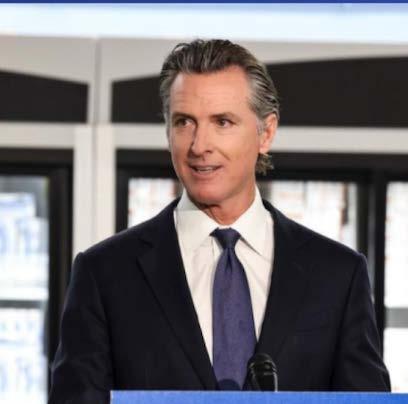The state of California and Los Angeles County this week declared a public health emergency over the novel coronavirus (COVID-19), with over 50 cases statewide and 13 cases confirmed in LA County alone.
Officials from the LA County Board of Supervisors and Department of Public Health on Wednesday, March 4 announced a public health emergency and reported six new cases in the county.
“I want to reiterate that this is not a response rooted in panic,” Kathryn Barger, chair of the Los Angeles County Board of Supervisors, said at a press conference on Wednesday, after signing a proclamation declaring a local emergency earlier that morning.
LA County Public Health Director Dr. Barbara Ferrer told reporters that the county is among 10 California health labs to receive test kits from the Centers for Disease Control and Prevention (CDC) to test for coronavirus locally and is slated to receive more.
“We will ensure that people who test positive for the novel coronavirus and their close contacts are identified and carefully monitored and supported while they are in isolation and/or quarantined,” Ferrer said.
The six cases were confirmed on Tuesday night after positive results from lab tests and the sources of the virus have been identified. One of the individuals is a medical professional who last worked as a passenger screener at Los Angeles International Airport on Feb. 21, and is now self-quarantined at home after feeling symptoms a week later.
“As of today, we still don’t have known cases of community transmission,” Ferrer said. She added that “the risk for individuals to be exposed to novel coronavirus here in LA County still remains relatively low.”
A day later, the health department reported four additional cases who returned from a trip to Northern Italy, while two more incidences were being investigated on Friday afternoon, bringing the total cases to 13 in the county.
All confirmed cases are being isolated and there are no known significant exposures to the general public, the department said. Those who have been in close personal contact with the individuals have been identified and are being monitored for signs and symptoms of the illness.
The county will also be doing daily radio briefing updates and providing additional guidance for childcare facilities, schools, businesses and other public spaces on how to prepare for and slow the spread of the virus.
“To ensure that the county is further prepared, these two declarations of emergency will allow us to further draw down resources from both the federal and state levels of government,” County Supervisor Hilda Solis said at the press conference. “We need every tool at our disposal to make sure we are ready to support any coronavirus patients who are diagnosed and to prevent any further spread.”
Solis also reminded the public about verifying information and preventing the spread of false reports.
“There’s been too much misinformation spreading around and as we expected, it’s cultivating fears and is leading to racial profiling,” she said, citing that many Asian and Pacific Islander (API) residents and businesses have been stigmatized.
LA County previously announced efforts in February to help combat xenophobia and other discriminatory acts associated with the panic over coronavirus.
In the county, which is home to roughly 1.5 million API residents, mass hysteria has come in the form of fake flyers falsely claiming cases of coronavirus, paranoia over seeing people wearing face masks and general “acts of hate” directed toward community, as previously reported by the Asian Journal.
California Governor Gavin Newsom on Wednesday also declared a state of emergency, as the state confirmed the first coronavirus-related death of a 71-year-old man in Placer County who developed symptoms after returning from a Grand Princess cruise from Mexico in late February.
The state of emergency was declared “to make additional resources available, formalize emergency actions already underway across multiple state agencies and departments, and help the state prepare for broader spread of COVID-19,” according to the governor’s office.
“The State of California is deploying every level of government to help identify cases and slow the spread of this coronavirus,” said Newsom. “This emergency proclamation will help the state further prepare our communities and our health care system in the event it spreads more broadly.”
The cities of Pasadena and Long Beach, which have their own health departments, declared local emergencies on Wednesday. Both cities have not reported any cases, as of press time.
Ferrer also reminded county residents to “adhere to common-sense public health practices” and that they plan “for the possibility of more extensive social distancing requirements.”
“These measures include having an ample supply of essentials at home — no different than the preparedness activities we ask people to do to be ready for natural disasters…” she added. “We do need folks to plan for the possibility of business disruptions, school closures and modifications or cancelations of select public events.”
Ferrer advised the public of tips like staying home if you are sick, frequent handwashing and limiting close contact with others.
COVID-19 is spread from person-to-person through close contact, usually within 6 feet, and mainly via respiratory droplets when an infected person coughs or sneezes, according to the CDC. Symptoms include fever, cough and shortness of breath.
There are currently no specific medications or vaccinations to treat COVID-19.
The CDC this week also issued new directives for travelers returning from high risk countries (e.g. China, Iran, Italy and South Korea). The guidance asks these travelers to distance themselves from the public for 14 days by staying home from work and/or school, avoiding public spaces and public transit, and monitoring themselves for signs and symptoms of respiratory illness. Should returning travelers from areas experiencing outbreaks develop illness, they should immediately call their health care provider.







